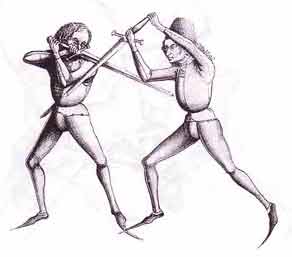| Archery |
| Brewing |
| Calligraphy & writing |
| Combat |
| Cooking |
| Dance |
| Etiquette |
| Household life |
| Medicine |
| Music |
| Needlework |
| Playacting |
| Religion |
| Storytelling |
Young noblemen and household officers hone their
skills by daily practice. The earlier period sees the use of the “hand-and-a-half
sword” and dagger, the slashing falchion and buckler (often used
by archers when the battle came hand to hand). Once the basic forms of
attack and parry were learned, a real fight to the death would seldom
last more than a few seconds. The weapons were heavy and an opponent might
as easily be disabled by a crushing blow from the pommel as by a cut from
the blade. Later the slim, elegant rapier and dagger became popular in
courtly circles whose members learned from Italian masters who had developed
fencing into an elaborate art, defined by rules. Much was learned from
fighting manuals of the different styles of attack and defence, several
of which we would show in bound facsimile editions. |

An Illustration from Tallhofer's Fighting Manual
| A sharp metal sword was used only in serious combat, a wooden waster being used for practising. Those training withheld the full impact of their blows but would develop strength at the "pell", often a tree stump, against which they could throw their whole weight to develop their musculature. Skeletons from the past often show thickening of bones caused by military training, archers showing the greatest diversity between their left and right arms, and frequently a torsion of the spine. |